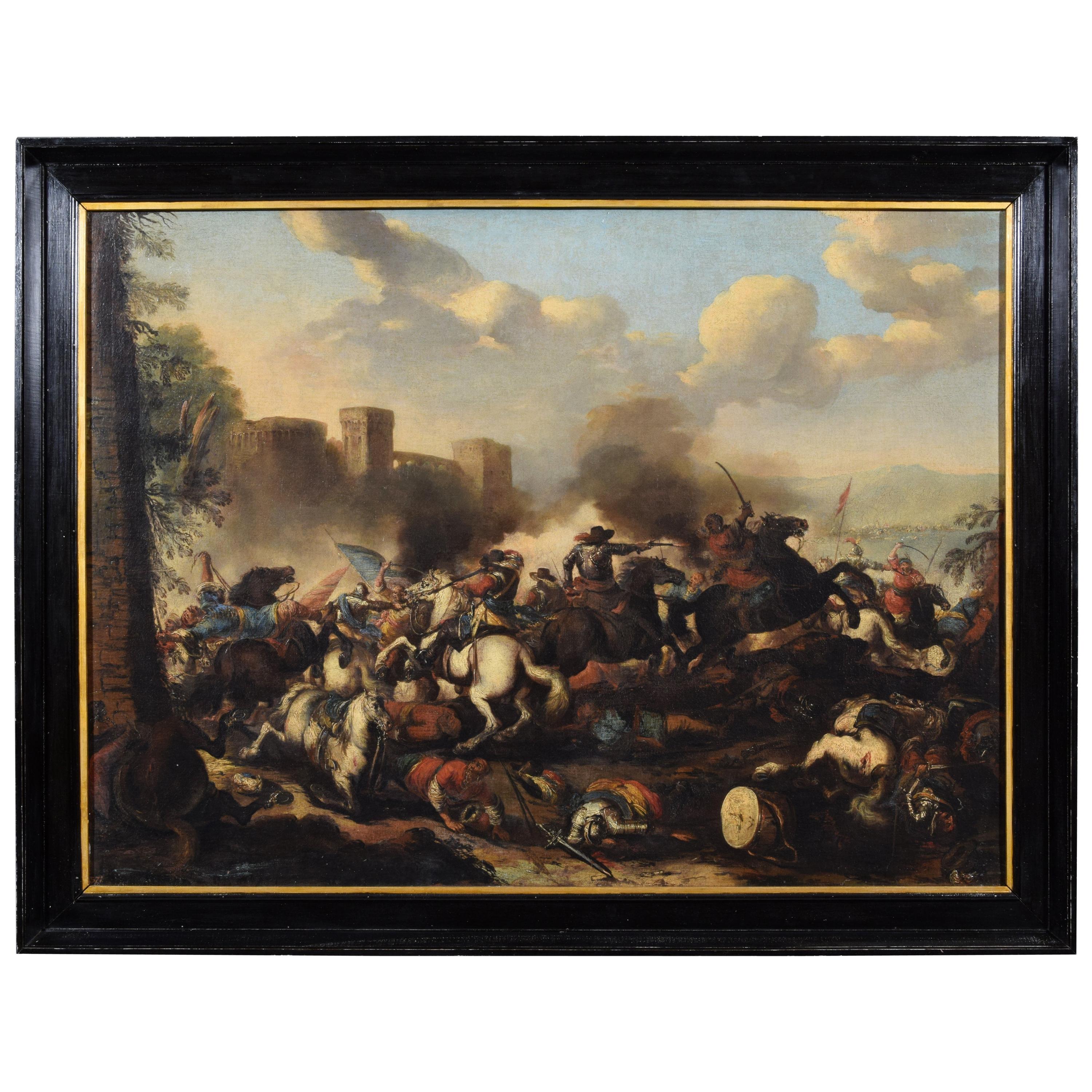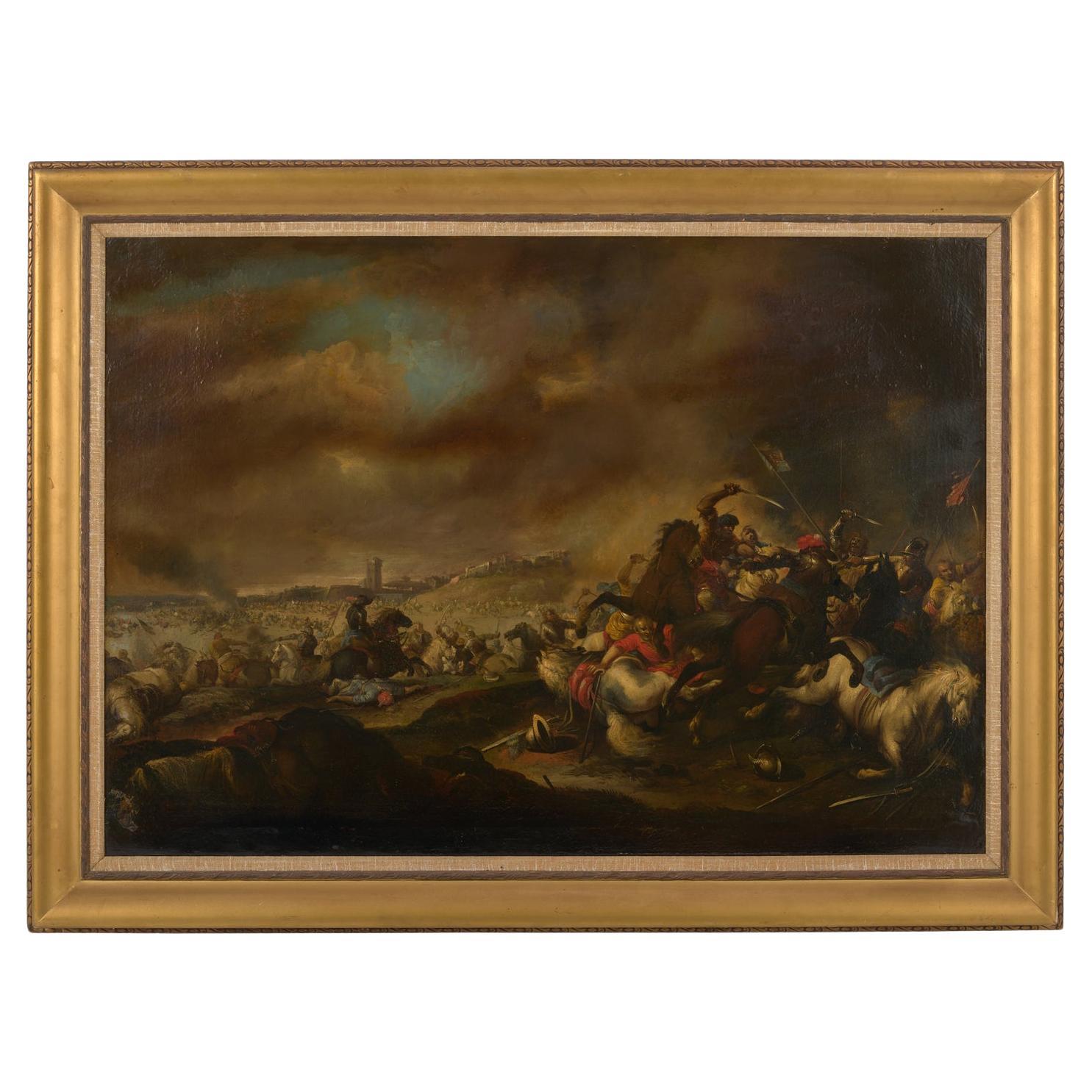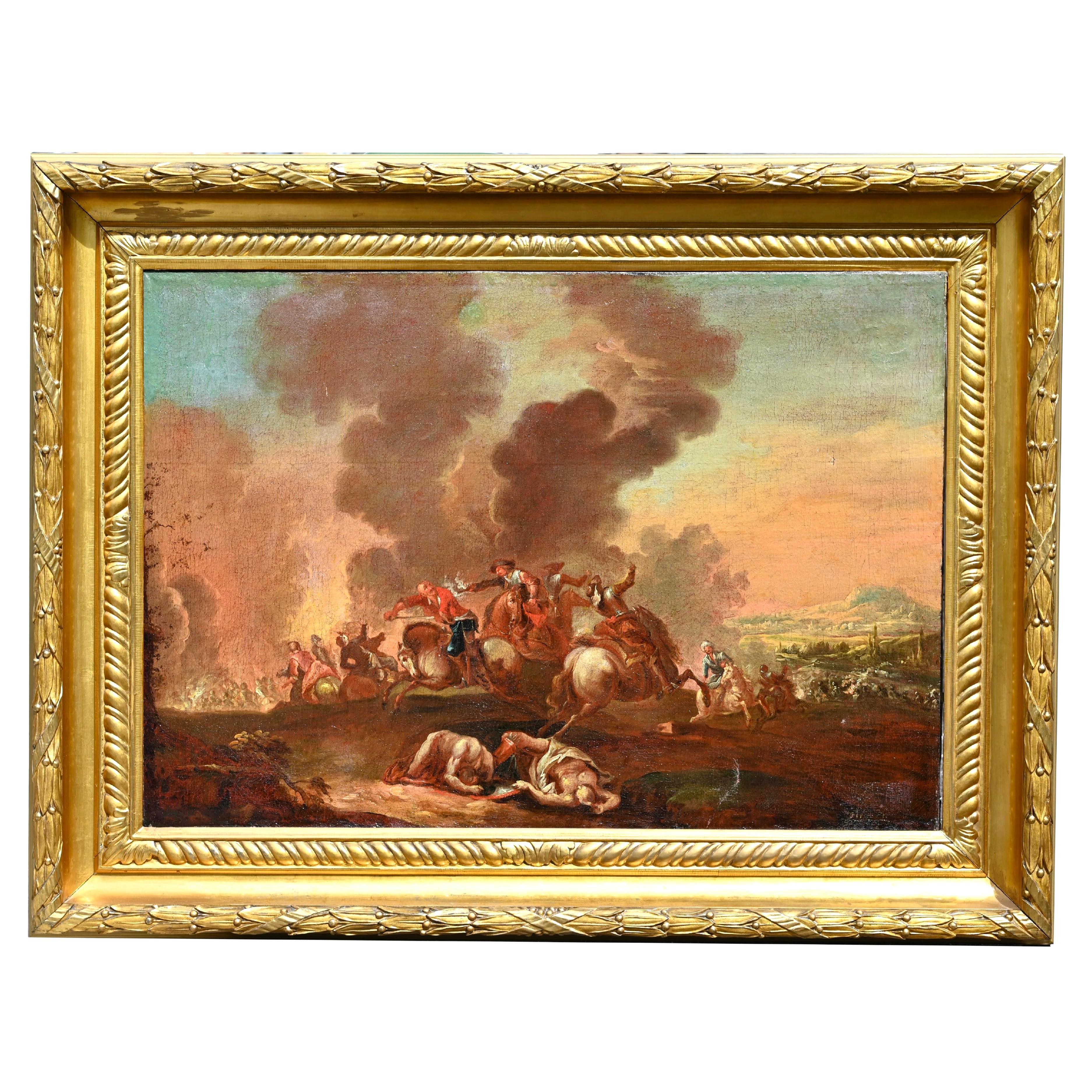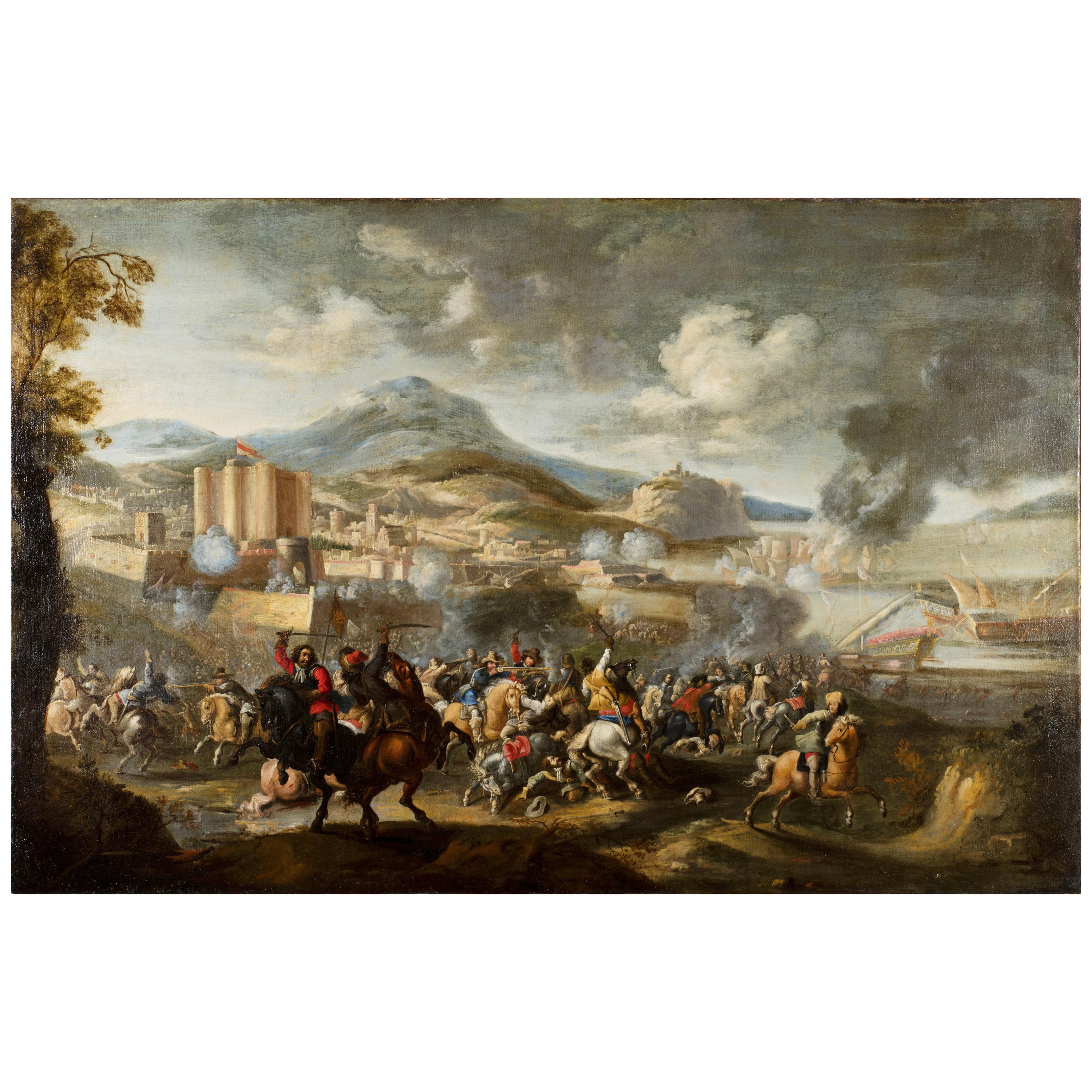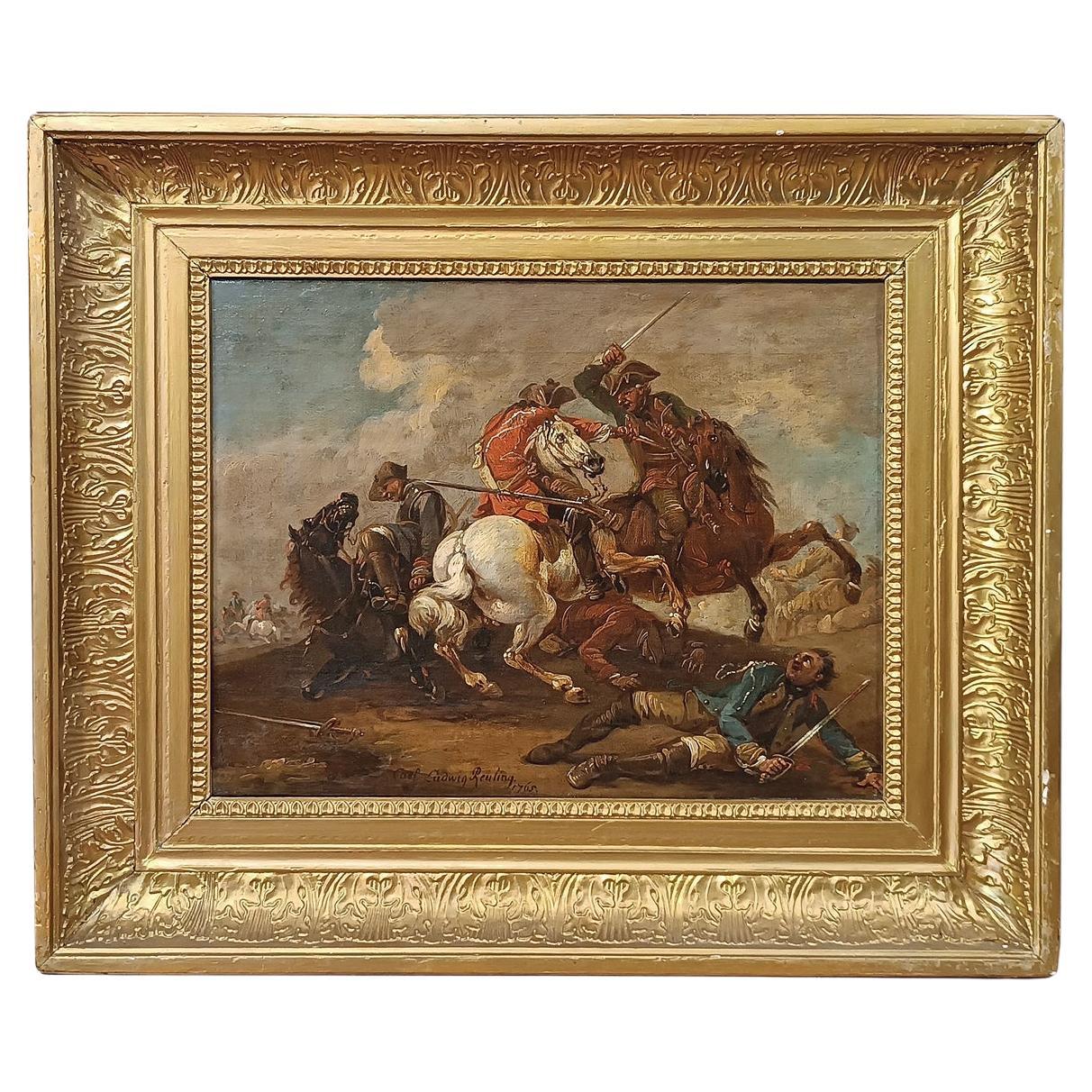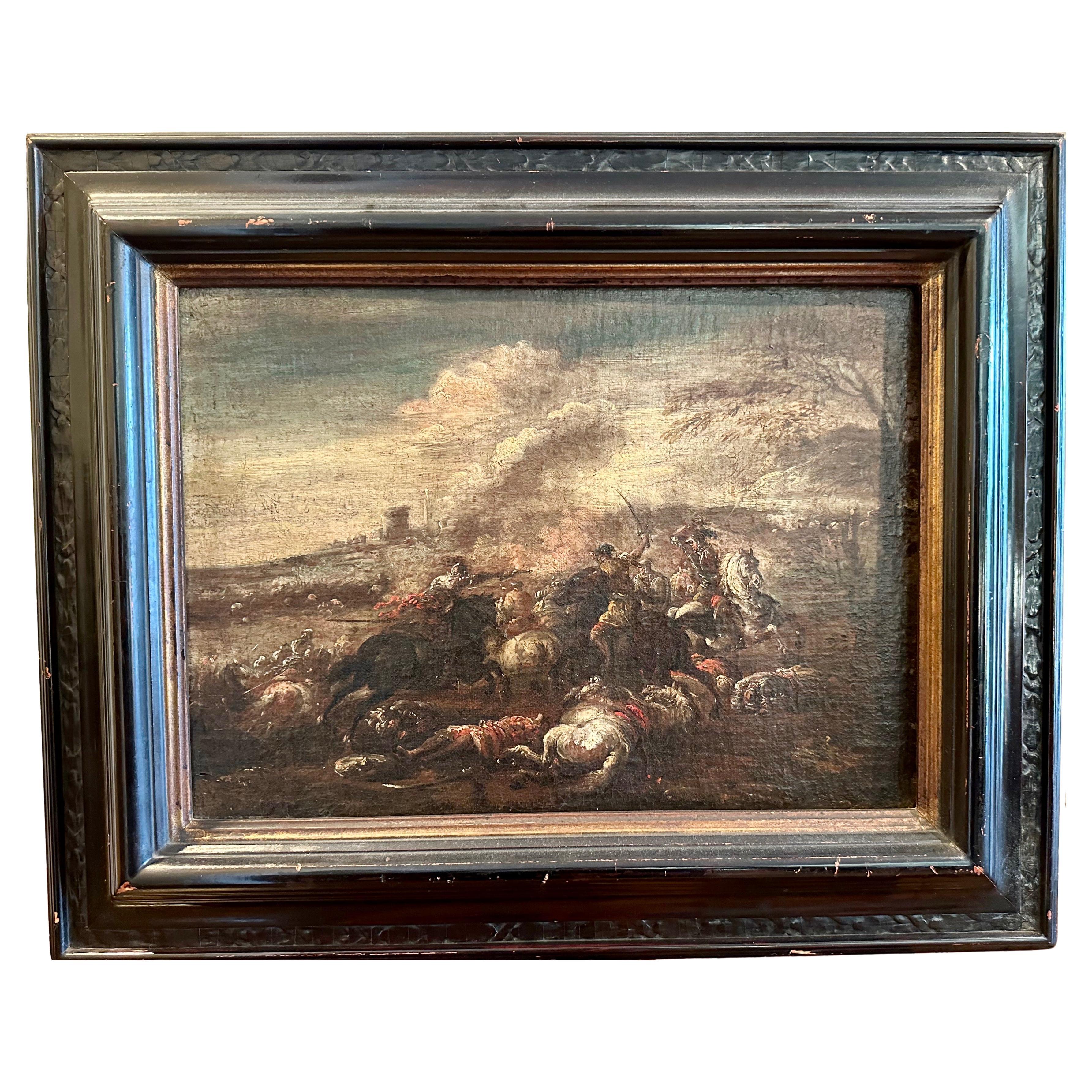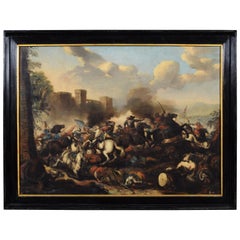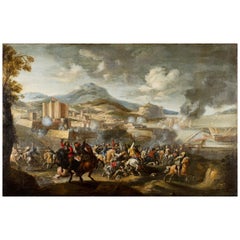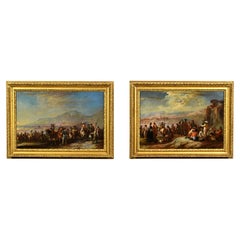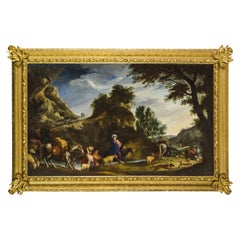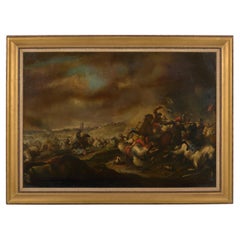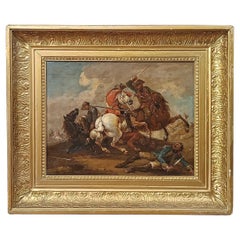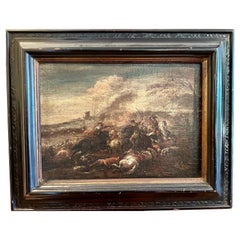Items Similar to 17th Century, Italian Painting with Battle Between Christian and Turkish Cavalry
Want more images or videos?
Request additional images or videos from the seller
1 of 15
17th Century, Italian Painting with Battle Between Christian and Turkish Cavalry
$41,935.03
£31,217.90
€35,000
CA$57,440.50
A$63,886.38
CHF 33,359.48
MX$777,429.24
NOK 426,051.47
SEK 399,561.12
DKK 266,442.78
Shipping
Retrieving quote...The 1stDibs Promise:
Authenticity Guarantee,
Money-Back Guarantee,
24-Hour Cancellation
About the Item
17th century, Italian oil on canvas painting with battle between Christian and Turkish cavalry
The oil on canvas painting depicts a battle between Christian and Turkish cavalry. Characterized by a strong dynamism, the main scene occupies the lower horizontal section of the canvas. In the background is the continuation of the clash just outside the walls of a city whose towers delimit the horizon. On the left some hills fade on the horizon. The sky is marked by clouds of serene contrast with the black smoke of the battle.
Stylistically the painting can be traced back to a painter active in Italy in the seventeenth century, continuator of the major interpreter of the genre, Jacques Courtois called Il Borgognone (Saint-Hyppolite 1621 - Rome 1676). The genre of battle painting met with great success in the collections of the Italian and European nobility of the 17th and 18th centuries and there are many painters who ventured in this thematic genre.
The battles of the Italian Renaissance, in which the scene converged towards a precise protagonist, evolved in the seventeenth century towards a type of combat "without hero". The bloody realism of the details and the dynamic development of the narrative confuse the figure of the protagonist, when present, to give importance to the swirl of horses and armed fighters, among which, moreover, does not emerge a winner.
It is currently the drafting of expertise of the work useful to identify the hand of the painter through historical artistic studies; in addition, new images will soon be inserted.
- Dimensions:Height: 30.32 in (77 cm)Width: 57.09 in (145 cm)Depth: 1.97 in (5 cm)
- Style:Baroque (Of the Period)
- Materials and Techniques:
- Place of Origin:
- Period:Mid-17th Century
- Date of Manufacture:Mid-17th Century
- Condition:
- Seller Location:IT
- Reference Number:1stDibs: LU4405221205492
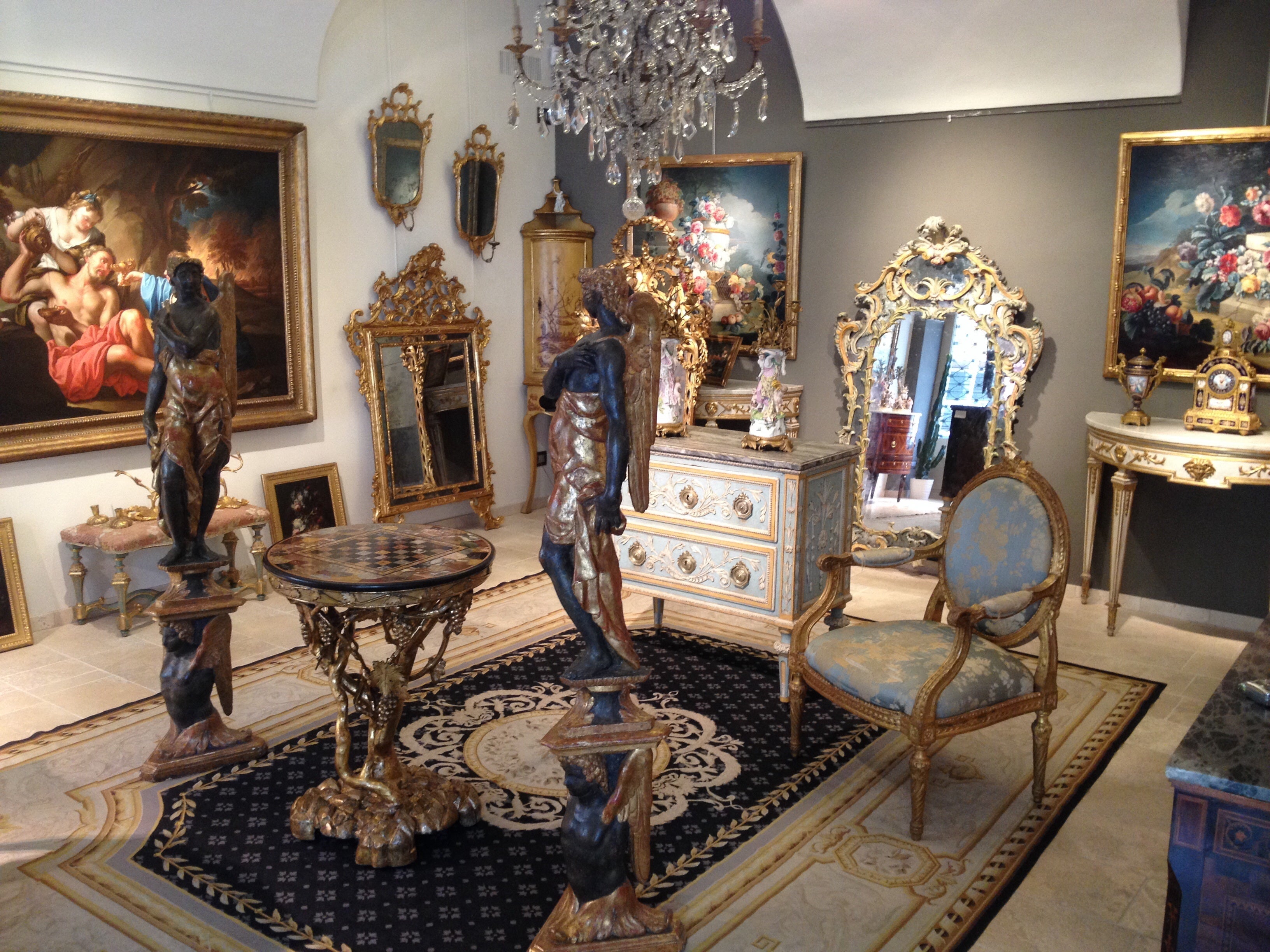
About the Seller
5.0
Platinum Seller
Premium sellers with a 4.7+ rating and 24-hour response times
Established in 1980
1stDibs seller since 2019
56 sales on 1stDibs
Typical response time: 1 hour
- ShippingRetrieving quote...Shipping from: Italy
- Return Policy
Authenticity Guarantee
In the unlikely event there’s an issue with an item’s authenticity, contact us within 1 year for a full refund. DetailsMoney-Back Guarantee
If your item is not as described, is damaged in transit, or does not arrive, contact us within 7 days for a full refund. Details24-Hour Cancellation
You have a 24-hour grace period in which to reconsider your purchase, with no questions asked.Vetted Professional Sellers
Our world-class sellers must adhere to strict standards for service and quality, maintaining the integrity of our listings.Price-Match Guarantee
If you find that a seller listed the same item for a lower price elsewhere, we’ll match it.Trusted Global Delivery
Our best-in-class carrier network provides specialized shipping options worldwide, including custom delivery.More From This Seller
View All18th Century Italian Oil on Canvas Painting with Battle by Antonio Calza
By Antonio Calza
Located in IT
Antonio Calza (Italy, Verona, 1653-18th April 1725)
"Battle between Christian and Turkish cavalry with castle"
The painting depicts a bloody battle between Christian and Turkish cavalry. Characterized by dynamism, intensity of color and light, the main scene occupies the lower horizontal section of the canvas, optically interrupted by the black fumes of the shots from which emerge, on the left, the towers of a fortress. On the right, in the distance you can see the combat in progress in the countryside, beyond which you can see the pale presence of hills that create a fifth, marking the horizon. To frame the scene contributes to the left, against light and in the foreground, a portion of the wall. The painter, however, introduces a horse on the ground, of which we see only the back, a ruse to involve the observer making him become active and participate in the scene. In the foreground, lifeless bodies, wounded horses and, scattered on the ground, weapons and a drum enhance the drama of the clash.
The excitement and expressive force, the intense chromatic range attentive to the conditions of light and the fine brushstrokes, decisive and dramatic, suggests the attribution to Antonio Calza, one of the most important painters of battles of the seventeenth century, excellent student and continuator of the greatest interpreter of the genre, Jacques Courtois called il Borgognone (Saint-Hyppolite 1621 - Rome 1676). Il Borgognone, although not having had a real school or direct students, places itself as a primary reference point by the Italian and foreign "battaglisti".
The genre of battle painting found great success in the collections of the Italian and European nobility of the seventeenth and eighteenth centuries. The battles of the Italian Renaissance, in which the scene converged towards a precise protagonist, evolve towards a type of combat "without hero". The bloody realism of the details and the dynamic development of the narrative confuse the figure of the protagonist, when present, to give importance to the swirl of horses and armed fighters, among which, moreover, does not emerge a winner.
The certain documents relating to the life and movements of Antonio Calza are scarce; it was equally difficult to reconstruct, from the critics, a catalogue of autograph works. Through paintings in private collections, in museums and paintings passed on the antiques market it has been possible to identify a copious corpus of works that can be traced back to his hand. The work of art historians, together with that of antique dealers, in conferring proper attributions in order to best outline the figure of Calza, continues but studies are still in progress. In this sense, the work of Giancarlo Sestieri should certainly be noted, who investigated the artistic production of the battaglisti and Calza, thus allowing the comparison of the numerous photographic works reported, to identify and recognize the stylistic qualities that distinguish the corpus of paintings assigned to him today.
Antonio Calza was born in 1653 in Italy, in Verona and in 1664 he entered the school of Carlo Cignani in Bologna, dedicating himself to painting battles and landscapes. He then perfected in Rome, where he knew the works of the then undisputed head of the sector, Jacques Courtois called the Burgundian. In 1675 he returned to Verona and married an 88-year-old widow who, dying, left him a rich inheritance. Much appreciated by the nobility and the bourgeoisie, he received numerous commissions. Bartolomeo Dal Pozzo (Le Vite de' pittori, de gli scultori et architetti veronesi, 1718) praises "three great paintings of battles...
Category
Antique Late 17th Century Italian Baroque Paintings
Materials
Canvas
17th Century, Italian Painting with Battle attributed to Marzio Masturzo
Located in IT
Marzio Masturzo, attributed (Active in Italy - in Naples and Rome- in the second half of the 17th century)
"Battle between cavalry and vessels with fortified city on the left"
...
Category
Antique Late 17th Century Italian Baroque Paintings
Materials
Canvas
$40,437 Sale Price
25% Off
18th Century, Italian Pair of Oil on Canvas Paintings by Francesco Simonini
By SIMONINI
Located in IT
Francesco Simonini (Parma, 16 June 1686 - Parma, 1766)
“The rest of the soldiers” and “The march of soldiers”
oil on canvas
cm 40 x 58 and 40 x 60 ; frame: h 52,5 x W 70,5 x D 6 an...
Category
Antique Early 18th Century Italian Baroque Paintings
Materials
Canvas
$28,036 Sale Price
35% Off
17th Century, Italian Painting by Pier Francesco Cittadini, Jacob and his Family
Located in IT
Pier Francesco Cittadini (Milan, 1616-Bologna, 1681)
"Jacob and his family go to Egypt"
Oil on canvas, cm 109 x 190 (canvas only)
The valuable painting, made in oil on canvas, depicts Jacob and his family go to Egypt and we believe it can be, given the high quality painting, autograph work of Italian Pier Francesco Cittadini (Italy Milan, 1616 - Bologna, 1681) made after 1647. The work, in excellent condition is accompanied by a coeval frame in wood finely carved and golden.
The scene depicted, which was confused with the Flight to Egypt in the past years, is instead identified with the biblical episode of Jacob’s journey. In the foreground, reading the painting from left to right, we see a caravan composed of animals, including donkeys, dromedaries, goats, dogs and horses and people, women, men and slaves, who carry on their journey along the banks of a river, following a path that to the right, would seem to lead to the through of a bridge. In addition to the watercourse is described an environment characterized by large rocks and impervious come far to cover the entire verticality of the canvas. On the left, in the distance, we see the tail of the caravan that runs along the steep path. Large trees enliven and harmonize the environment, as well as white and grey clouds characterize the predominantly clear sky and illuminated on the right by sunlight.
The story is told in the Bible, Book of Genesis, 30, 25, passage in which is described the flight of Jacob from Haran after the contrasts with Laban, father of his wife Rachel. Jacob is the third great patriarch of the Bible. From his descendants originate the twelve generations of the people of Israel. He is the son of Isaac and Rebekah, who led him to flee from the wrath of Esau to Haran to seek refuge from his brother, Laban. At his uncle’s house Jacob met his daughter Rachel. As soon as he saw his cousin, Jacob was taken. Jacob will stay seven years in the service of Laban to marry his beloved Rachel. But Laban, with a deception, will give him in marriage first Lia, the least beautiful eldest daughter, and only after another seven years the splendid Rachel. From his first wife he will have several children, while Rachel will give birth to the beloved son, Joseph, who will become viceroy of Egypt.
After years of service, Jacob asked to be paid with every dark-coloured garment among the sheep and every spotted and dotted garment among the goats. Laban accepted and sent away from his sons all the leaders of that kind. So Jacob took fresh branches of poplar, almond and plane tree, and flayed them, and put them in the troughs. The optical suggestion induced the goats and the sheep to conceive and give birth to dark, striped and dotted garments. He also ensured that all the strongest and healthiest leaders of the flock of Laban would drink near the barked branches, thus assuring a genetic superiority to his part of the flock. His flocks grew numerous and strong and he became richer than his relative, arousing envy. It was clear that Laban would not respect him much longer. At the suggestion of the Lord, Jacob decided to return to Canaan. Trying to avoid any possible dispute, he left with his family while Laban was absent for shearing sheep. But when, three days later, his uncle returned home, he became angry, feeling offended because Jacob had gone secretly and had not allowed him to greet his daughters and grandchildren. In addition, his teraphim, statuettes, or idols, which depicted the family deities, had disappeared. After 7 days of pursuit, Laban and his men reached Jacob’s group on Mount Gilead, in the mountainous region west of the Euphrates River, where his uncle and grandson had a stormy conversation. The younger man was outraged at being accused of stealing idols and told Labano to rummage through his family’s tents at will. Neither of them could know or even imagine that it was Rachel who took the idols and hid them in the saddle of the camel. During the search, she sat down firmly on the saddle, apologizing for not being able to get up, «because I usually have what happens to women» (Gen 31:35). So the loot wasn’t discovered.
The author of this work was inspired by the composition of an engraving by Stefano Della Bella (1610-1664) of circa 1647. The engraving by Stefano della Bella bears the title "Iacob sur ses vieux jours quitte sans fascherie pour voir son filz Ioseph, sa terre et sa patrie" and is signed on the bottom left "Stef. of the Beautiful In. et fe." while on the right it is declared "Cum privil. Regis", that is with license of the king.
Stefano Della Bella (Italy - Florence, May 18, 1610-Florence, July 12, 1664) was born in a family of painters, sculptors and goldsmiths and was left early orphan of his father sculptor, he dedicated himself first to the art of goldsmith at the school of Giovanni Benedetto Castiglione and Gasparo Mola, then turning his attention to drawing and engraving. He soon began drawing figures and copying the etchings of Jacques Callot, which inspired his early works. Under the protection of the Medici, in particular of Don Lorenzo, cadet son of Grand Duke Ferdinand I, Della Bella has the opportunity to make study trips to Rome, where he stayed from 1633-1636; In Rome he met French engravers and publishers of prints such as Israël Henriet and François Langlois, who influenced his decision to move to Paris in 1639, four years after the death of Callot. In Paris he soon reached, thanks to the engravings commissioned by Cardinal Richelieu, the success also worldly; he frequented courtiers, theatre artists and writers, while refusing too oppressive honors. In 1646-1647 he continued his travels in the Netherlands to Amsterdam, Antwerp and Dordrecht. He returned to Florence in 1650 and resumed working under the protection of the Medici court, working for his patrons. In 1656 he became a member of the Academy of Apatists.
The painting object of this study is reasonably attributable to Pier Francesco Cittadini, or Pierfrancesco Cittadini, called the Milanese or the Franceschino (Italy - Milan, 1616-Bologna, 1681) as some exemplary stylistic comparisons proposed to follow can prove.
Pier Francesco Cittadini was an Italian baroque painter, mainly active in Bologna.
His artistic training first took place with the painter Daniele Crespi...
Category
Antique Mid-17th Century European Baroque Paintings
Materials
Canvas, Giltwood
18th Century, Baroque Austran Painting by August Querfurt
Located in IT
August Querfurt (1696, Wolfenbüttel - 1761, Vienna)
Farmers and villagers at the entrance of a village
Oil on panel , cm 38,5 x 51. frame 66 x 53,5 x 4,5 cm
The valuable painting, ...
Category
Antique 18th Century Austrian Baroque Paintings
Materials
Wood
18th Century, Italian painting Depicts Bambocciata by Giovanni Michele Graneri
Located in IT
Giovanni Michele Graneri (Italy, Turin 1708-1762)
Bambocciata (Farmers dancing in front of the inn)
The painting, made in oil on canvas, depicts a moment of celebration where some p...
Category
Antique Mid-18th Century Italian Baroque Paintings
Materials
Canvas
You May Also Like
A Late 17th Century Painting Depicting A Cavalry Battle
Located in ARMADALE, VIC
A Late 17th Century Painting Depicting A Cavalry Battle
Height: 115 cm Width: 75 cm Depth: 6 cm.
Provenance: Private Australian Collection.
Category
Antique Late 17th Century Italian Baroque Paintings
Materials
Canvas
17th Century Old Master Painting, Large Battle Scene, Oil on Canvas
Located in Bradenton, FL
17th Century Large Old Master Battle Scene Painting. Flemish School, circa 1610 - 1680. Oil on canvas painting depicts a dynamic battle scene fi...
Category
Antique 17th Century Dutch Baroque Paintings
Materials
Canvas
LATE 18th CENTURY PAINTING WITH A BATTLE SCENE
Located in Firenze, FI
Oil painting on wooden canvas, accompanied by a carved and gilded wooden frame, decorated with geometric and floral motifs. In the center, the scene depicts a battle, with two main c...
Category
Antique Late 18th Century Austrian Paintings
Materials
Canvas, Wood, Paint
Italian Francesco or Pietro Graziani Neapolitan battle scene, 17th/18th Century
Located in CH
Italian Francesco or Pietro Graziani Neapolitan battle scene, 17th/18th Century
This battle scene is attributable to one of the two Graziani ( Francesco or Pietro) battle scene pain...
Category
Antique Late 17th Century Italian Baroque Paintings
Materials
Canvas
17th Century Oil on Canvas French Antique Battle with Soldiers Painting, 1670
Located in Vicoforte, Piedmont
A major battle from the second half of the 17th century. Oil on canvas painting depicting a dramatic battle between Christian and Eastern knights. In the foreground, a warrior wearin...
Category
Antique 1670s French Paintings
Materials
Canvas
Mid 19th Century Large Original Oil on Canvas Painting of Battle Scene Surrender
Located in Round Top, TX
Large original oil on canvas painting of battle scene with a defeated commander surrendering. Unsigned.
Ascribed to Jacques Courtois (b. Saint-Hip...
Category
Antique Mid-19th Century Danish Paintings
Materials
Canvas, Wood, Paint
